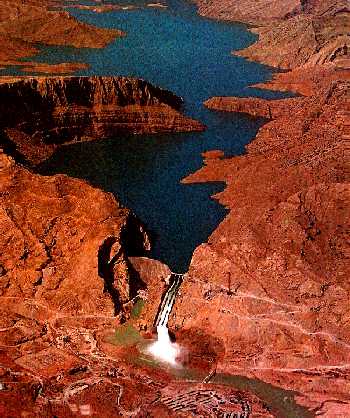


Arizona's Hoover dam? No, the "Dez - Reza Shah Kabir " dam which
harnesses
the considerable power of the Karun River in Iran's northern Khuzestan.
The dam , one of the highest in the world, is an important link in Iran's
growing need for electricity
and a major source for irrigation in the area.
Iran's power industry developed enormously during the sixties and seventies, with the consumption of electricity increasing at an average annual rate of about 30 per cent.
The Ministry of Energy, previously called the Ministry of Water and Power, was established in 1963 with the object of making electric power readily available throughout the country, including the smallest villages. The Ministry first took over the antiquated and often uneconomic private power companies and during the Fourth and Fifth Plans embarked on long-term expansion programmes.
The total number of electricity consumers increased from under 500,000 in 1963 to well over two million in 1976. Per capita consumption of electric power also rose dramatically, from 157 kilowatt-hours in 1967 to 425 kilowatt-hours in 1974. The Fifth Plan target was to increase this to over 800 kilowatt-hours by 1977 and it was done.
These very high rates of increasel have been made possible by massive; investment in generating, transmission and distribution systems, which in the Fifth Plan alone amounted to about 4.51 billion dollars. By 1975 generating capacity totalled 3,500 megawatts and by 1977 total installed capacity exceeded 7,000 megawatts. The national grid comprised 3,449 kilometres of 230 kV and 3,740 kilometres of 132 kV line, with a further 800 kilometres of 400 kV line entering service in 1976. The distribution system was constantly expanded and improved.
In 1978, about 30 per cent of power generation was accounted for by hydroelectric stations and the remainder by thermal power plants, including steam gas turbine and diesel generators.
With a view to reducing reliance on hydrocarbons as a source of energy and thus conserving them for more valuable use as petrochemical feedstocks the Ministry was actively seeking to diversify its sources of primary energy Because of the limited expansion potential for hydroelectric generation, attention was paid to nuclear power plants, and a number of contracts were signed. The Atomic Energy Organization of Iran programme called for the first such plants at Bushehr to be operational by 1980, and training courses for personnel have begun. Other source. of energy being investigated are geothermal resources and solar energy, the potential for which is obviously high in Iran despite the many technical problems involved.
The availability of adequate anc regular supplies of low-cost power in all urban areas was contributing greatly to industrialization and higher living standards. Expanding generating and transmission networks were also playinc their part in the introduction of more advanced agricultural techniques, and enabling villagers to enjoy a better life.